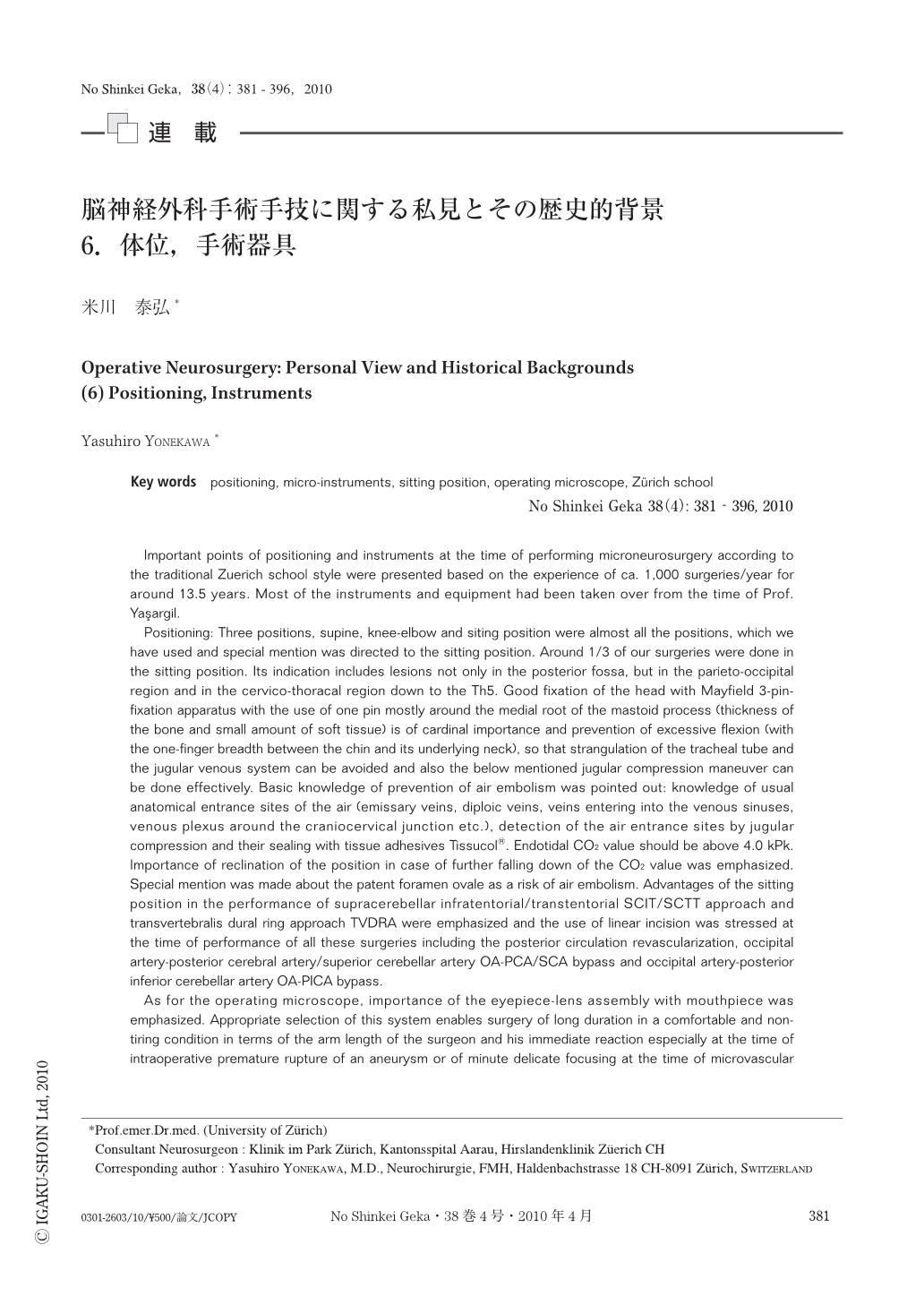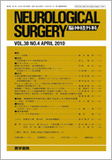Japanese
English
- 有料閲覧
- Abstract 文献概要
- 1ページ目 Look Inside
- 参考文献 Reference
Ⅰ.はじめに
少し間が空いたが,前回(37巻1号)はmeningiomaがテーマであった.次回は後頭蓋窩動脈瘤ないしは後頭蓋窩腫瘍について述べたいと思う.その前に,これらの手術を行う際にどうしても必要なことなので,この辺で,やはり今回のテーマ「体位,手術器具」について述べておきたい.
この稿の執筆を終える数日前に,左前頭葉(gyrus frontalis superior)の後半に首座を持つoligodentroglioma grade Ⅱで11年前にsubtotal removalを行った症例を再手術した.
Grade Ⅱであったので,術後照射あるいはchemotherapyは行わず,定期的に外来観察のみで経過した.最近speech arrestを伴うfocal seizureが抗癲癇薬の投与にもかかわらず頻繁に出現すること,および前回手術の腫瘍除去腔の後半部分に造影剤を摂取する部分が出現し,それに伴い除去腔壁に残存している腫瘍の増殖傾向がみられた.前回の術後,右片麻痺を伴った言語障害が一過性に出現したため,この手術をするにあたって以下の準備をした:functional MRI,術中open MRI,術中strip electrodeによるmotor strip stimulation,ステルスnavigation,5 aminolevulinic acid(5ALA).このような検査,手技のため時間はかかったが,幸いsubtotal removal手術は予定通り大過なく経過し,その患者は術後何の新しい神経脱落症状もなく覚醒した.
本稿では,これらの準備した最近の補助手術装置,検査についての詳細を述べるのではないことを,前もって,お断りしておく.ここではこれらの装置がなくても,基本的には安全な手術できること,またこれらを使ってもなお手術遂行に伴い必要な基本的な体位,頭位,手術器具などについて述べたい.
Important points of positioning and instruments at the time of performing microneurosurgery according to the traditional Zuerich school style were presented based on the experience of ca. 1,000 surgeries/year for around 13.5 years. Most of the instruments and equipment had been taken over from the time of Prof. Yaşargil.
Positioning: Three positions, supine, knee-elbow and siting position were almost all the positions, which we have used and special mention was directed to the sitting position. Around 1/3 of our surgeries were done in the sitting position. Its indication includes lesions not only in the posterior fossa, but in the parieto-occipital region and in the cervico-thoracal region down to the Th5. Good fixation of the head with Mayfield 3-pin-fixation apparatus with the use of one pin mostly around the medial root of the mastoid process (thickness of the bone and small amount of soft tissue) is of cardinal importance and prevention of excessive flexion (with the one-finger breadth between the chin and its underlying neck), so that strangulation of the tracheal tube and the jugular venous system can be avoided and also the below mentioned jugular compression maneuver can be done effectively. Basic knowledge of prevention of air embolism was pointed out: knowledge of usual anatomical entrance sites of the air (emissary veins, diploic veins, veins entering into the venous sinuses, venous plexus around the craniocervical junction etc.), detection of the air entrance sites by jugular compression and their sealing with tissue adhesives Tissucol®. Endotidal CO2 value should be above 4.0 kPk. Importance of reclination of the position in case of further falling down of the CO2 value was emphasized. Special mention was made about the patent foramen ovale as a risk of air embolism. Advantages of the sitting position in the performance of supracerebellar infratentorial/transtentorial SCIT/SCTT approach and transvertebralis dural ring approach TVDRA were emphasized and the use of linear incision was stressed at the time of performance of all these surgeries including the posterior circulation revascularization, occipital artery-posterior cerebral artery/superior cerebellar artery OA-PCA/SCA bypass and occipital artery-posterior inferior cerebellar artery OA-PICA bypass.
As for the operating microscope, importance of the eyepiece-lens assembly with mouthpiece was emphasized. Appropriate selection of this system enables surgery of long duration in a comfortable and non-tiring condition in terms of the arm length of the surgeon and his immediate reaction especially at the time of intraoperative premature rupture of an aneurysm or of minute delicate focusing at the time of microvascular suturing without withdrawal of one or both hands from the operative field for handling the operating microscope.
An arm rest enables secure, effective, precise and tireless performance of microsurgery in every operating position, so that the use of height an adjustable oil pressure driven arm rest was presented. along with a simply height adjustable and easily movable chair.
As for the bipolar coagulator pincette, the followings were discussed: more than three different lengths of byonett forceps, each of three different tip-sizes, with isolated tips, dosis and method of coagulation. Practically no need of monopolar coagulation was pointed out. Suction tube also should have different length and size according to the depth and situations. Its vacuum power should be regulated also in accordance with changing situation in every stage of surgery. The vacuum power is regulated at surgeon's request by scrub nurses or circulating nurses, so that the surgeon can concentrate only on the precise maneuver of the tip of the suction tube.
For the same reason, foot pedals for the bipolar coagulator, drilling and trepanation should be stepped by other than the surgeon, so that he can concentrate on the tip the of instrument for precise maneuvering.
As tissue destruction apparatus, we prefer to use CUSA to laser, as the former enables preservation of blood vessels at the time of tissue destruction and suction by appropriate power application.
Besides these,the followings items were discussed: scissors (blunt tips),Lyla retractor (variously tapered tips and fixation or holding at the other peripheral end),drilling (turning direction adjustable,cutting and diamond burr) etc.

Copyright © 2010, Igaku-Shoin Ltd. All rights reserved.


